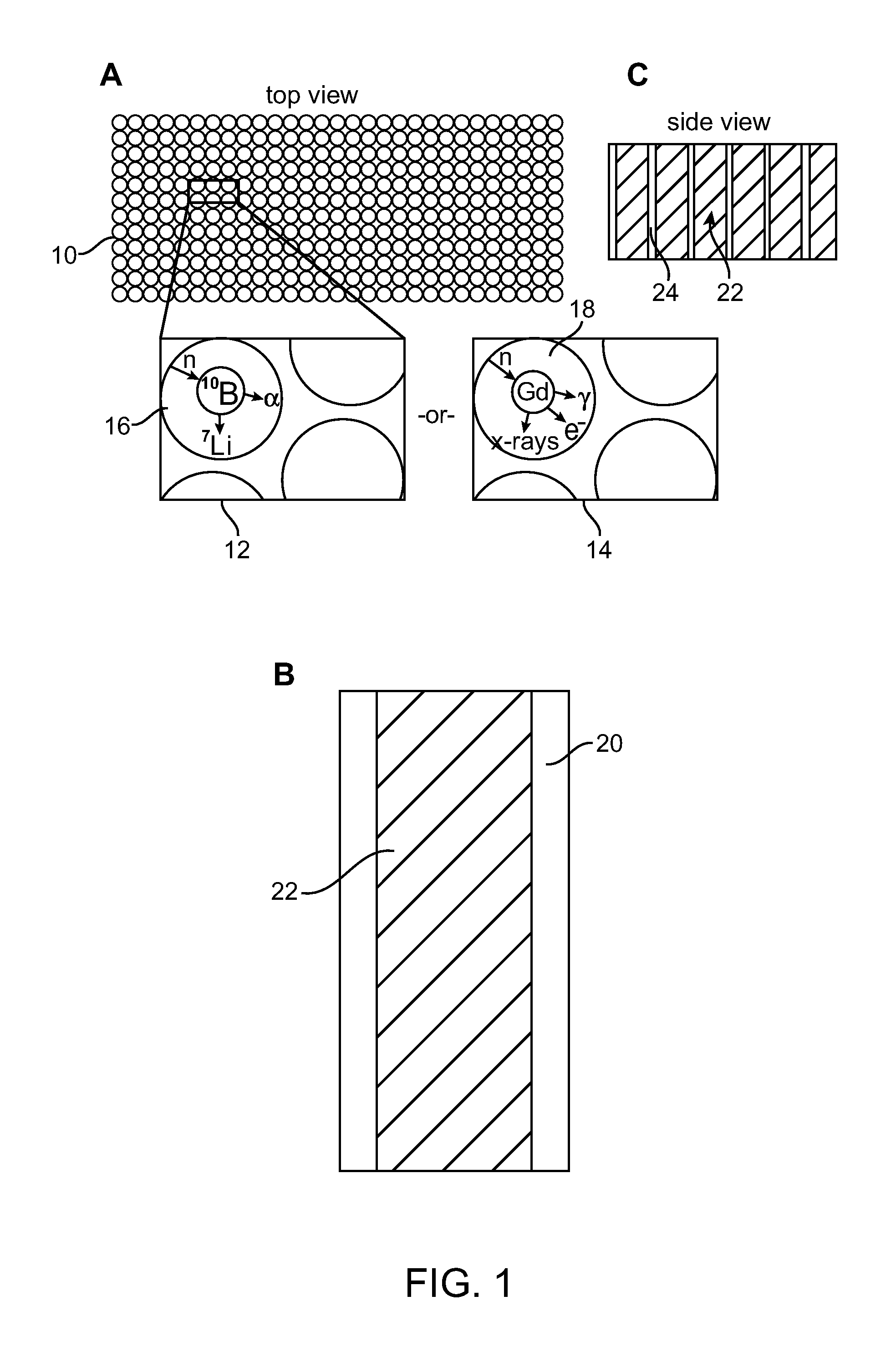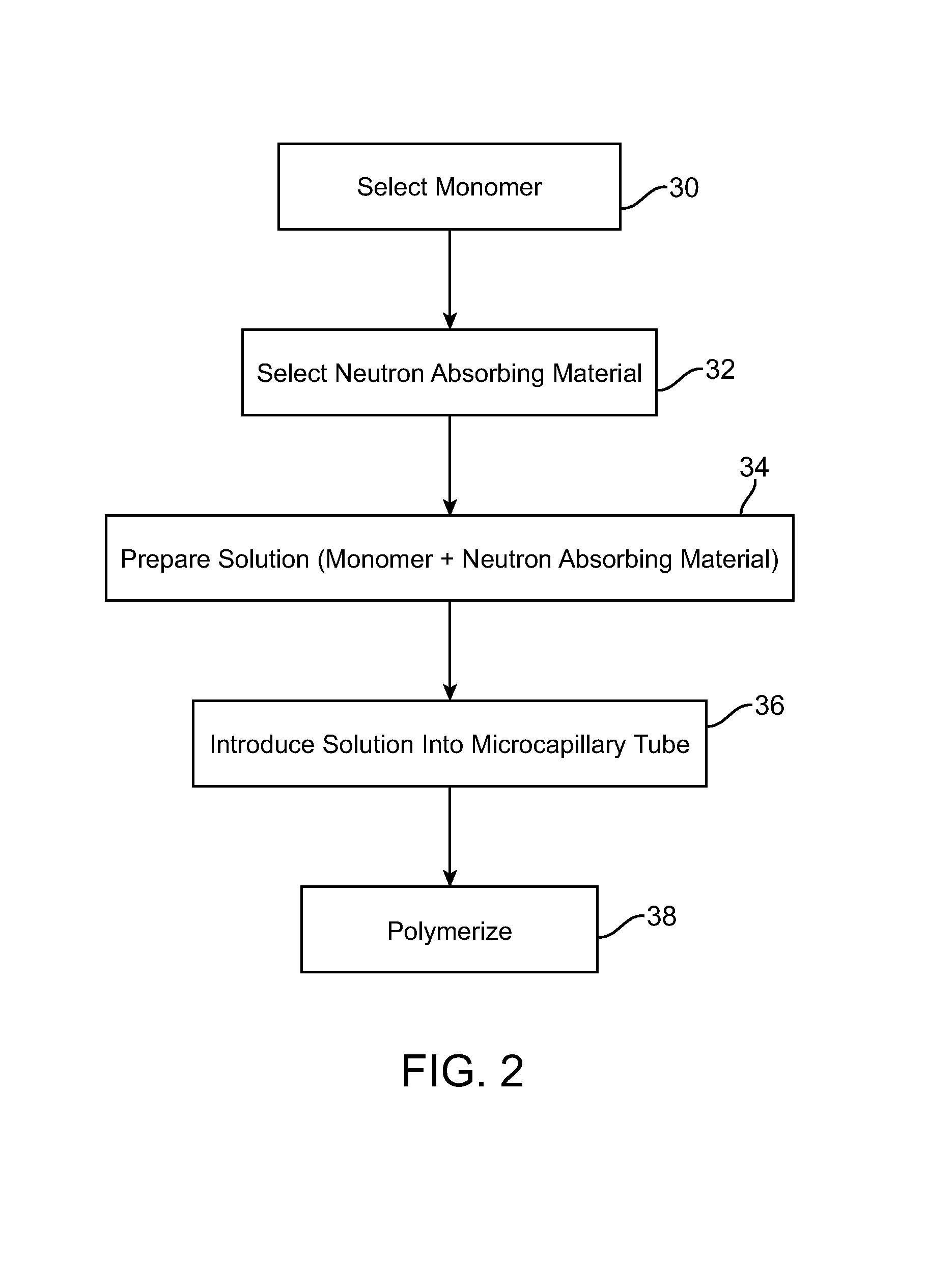[0008]The columns formed by the microcapillaries can vary in length and, in some embodiments, can be made long to enhance detection efficiency without sacrificing spatial resolution. For increased
neutron detection efficiency, the microcapillary material, such as
glass forming a microcapillary tube, may be doped with special additives which have high thermal neutron cross-section. Devices and assemblies can further include an optically coupled
photodetector or
high resolution readout to realize high performance neutron detection. Another
advantage of the present invention is that the scintillators can be fabricated in a large area with relatively low cost.
[0009]Additionally, the high-performance,
high resolution characteristics of the present neutron detecting scintillator devices are advantageously suitable for use in a wide variety of applications, including dynamic studies. For example, the fast decay of the scintillator allows for high count rates (e.g., up to about 100 MHz) and suitability for dynamic studies. The neutron detecting scintillators have time decay constants in the
nanosecond range, which is significantly faster than neutron sensitive scintillators used for imaging having time decay constants in the μs-ms range. For example, in one embodiment it is expected that the disclosed scintillator could reach
nanosecond response in the range of 1 to 250 ns while providing very
high spatial resolution imaging capability. In one embodiment, for example, scintillators of the invention are configured for
high spatial resolution imaging, the imaging comprising a spatial resolution with a value less than about 100 μm (e.g., better than about 100 μm), and typically less than about 50 μm (e.g., about 45 μm). Optionally, scintillator compositions can further include additional elements to effect composition characteristics, such as materials that waveshift the
emission spectrum of the scintillator composition, for example, so as to select a
quantum efficiency to better match optically coupled photodetectors or readouts.
[0010]Thus, in one aspect the present invention includes a neutron detecting scintillator. The neutron detecting scintillator includes a plurality of microcapillary tubes loaded with a scintillator composition comprising a plastic scintillator and a neutron absorbing material. Additionally, the capillary array can be focused toward the
radiation source, for example, where the source of neutrons is viewed through a pinhole-
collimator, or through a
coded aperture mask for applications such as detecting hidden illicit radioactive materials. Thus in one embodiment of the present invention the capillary array of a scintillator, or at least a plurality of capillaries or loaded microcapillary tubes of the scintillator are said to be “focused” or oriented to substantially match a predetermined illumination direction of a
radiation beam reaching the pixel.
[0011]In another aspect, the present invention provides methods of producing a neutron detecting scintillator having a plurality of microcapillary tubes loaded with a scintillator composition comprising a plastic scintillator and a neutron absorbing material. The method includes preparing a solution comprising a
monomer and a neutron
absorbing element, introducing the solution into a microcapillary tube of the plurality, and polymerizing the solution within the microcapillary tube.
[0012]The present invention can also make use of tubes having dimensions that are larger in size, which can be manipulated and / or drawn down into microcapillary sized tubes, for example, following introduction of a solution or scintillator composition into the tube. Thus, in yet another aspect of the present invention, a method of producing a neutron detecting scintillator having a plurality of microcapillary tubes loaded with a scintillator composition comprising a plastic scintillator and a neutron absorbing material, such a method includes preparing a solution comprising a
monomer and a neutron
absorbing element. The method additionally includes introducing the solution into a tube and drawing down the tube to form a microcapillary tube. Following drawing down of the tube, the method includes polymerizing the solution within the microcapillary tube.
[0013]Methods of the invention can include polymerizing a solution disposed within a tube prior to drawing down the tube to form a microcapillary tube. Thus, in one embodiment the present invention provides methods of producing a neutron detecting scintillator having a plurality of microcapillary tubes loaded with a scintillator composition comprising a plastic scintillator and a neutron absorbing material, the method includes preparing a solution comprising a monomer and a neutron absorbing element, introducing the solution into a tube, polymerizing the solution within the tube, and then drawing down the tube to form a microcapillary tube.
 Login to View More
Login to View More  Login to View More
Login to View More 


